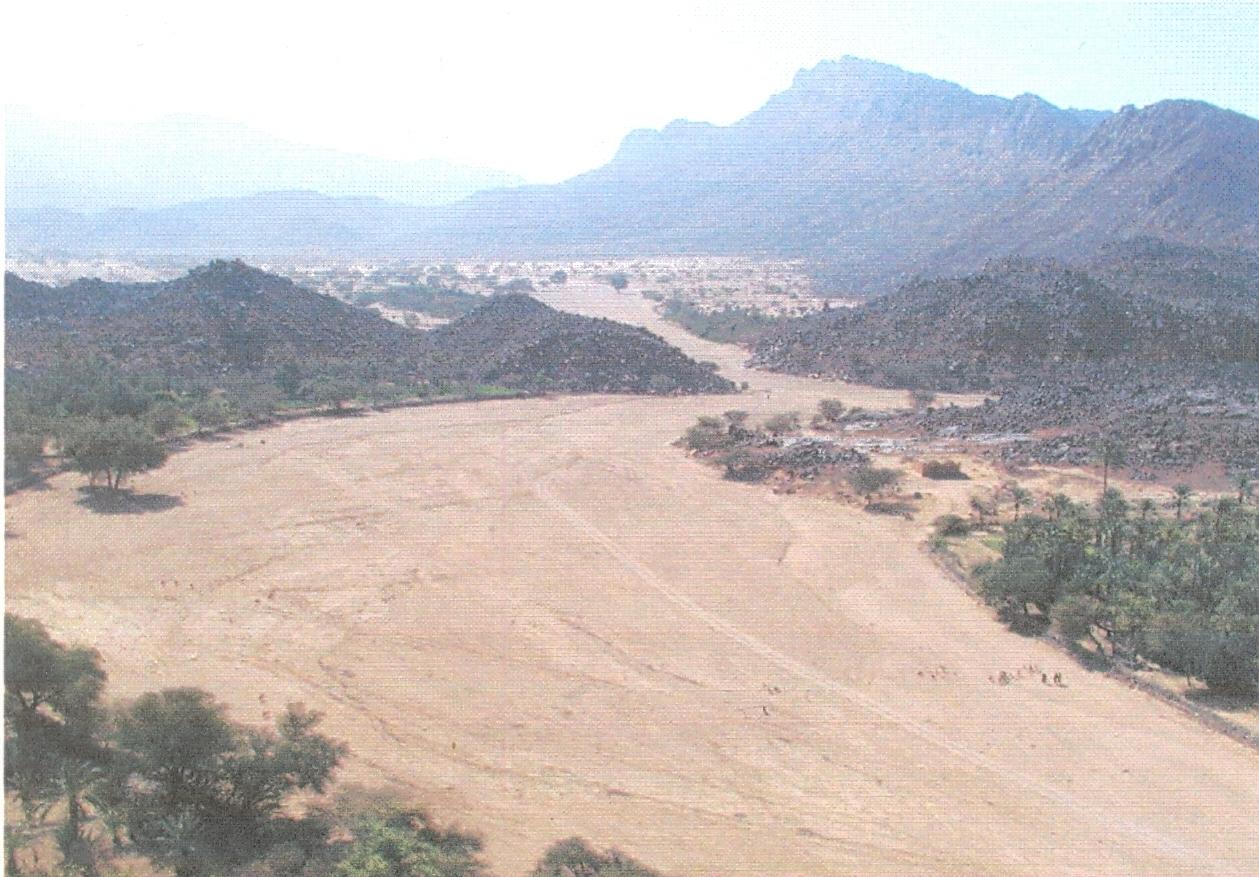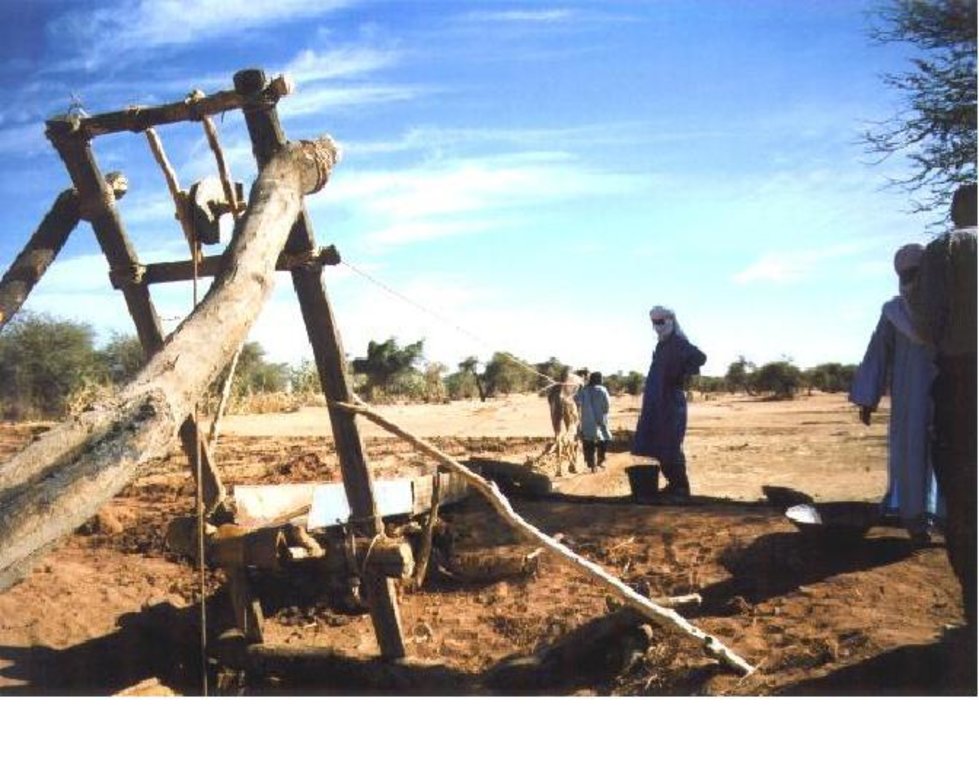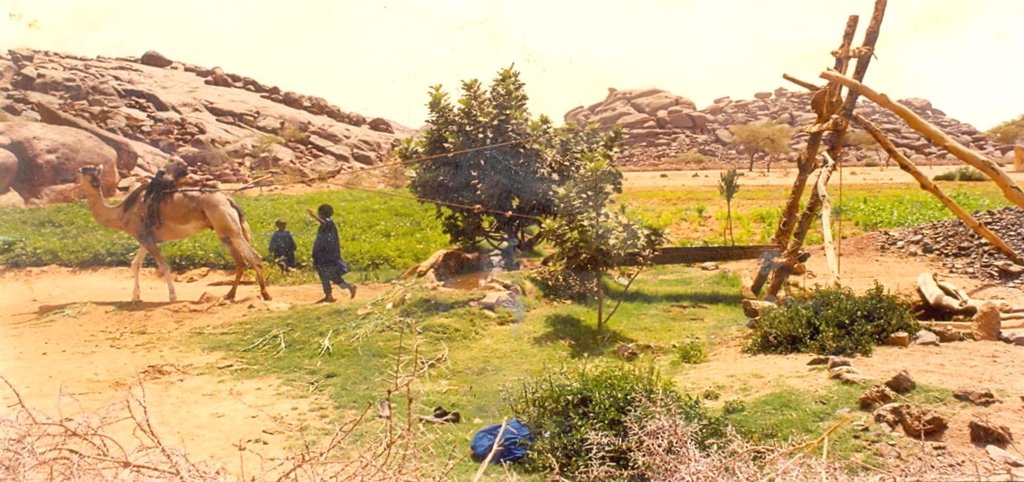Irrigated Oasis gardens [尼日尔 ]
- 创建:
- 更新:
- 编制者: Julie Zähringer
- 编辑者: –
- 审查者: Alexandra Gavilano, David Streiff
technologies_947 - 尼日尔
查看章节
全部展开 全部收起1. 一般信息
1.2 参与该技术评估和文件编制的资源人员和机构的联系方式
有助于对技术进行记录/评估的机构名称(如相关)
GREAD (GREAD) - 尼日尔1.3 关于使用通过WOCAT记录的数据的条件
编制者和关键资源人员接受有关使用通过WOCAT记录数据的条件。:
是
2. SLM技术的说明
2.1 技术简介
技术定义:
Oasis gardens in Niger for crop, vegetable and fruit production are supplied with irrigation water from traditional wells.
2.2 技术的详细说明
说明:
In Timia Oasis in Aïr, small irrigated gardens (< 0.3 ha) have been used for over a century, producing dates and tree crops (figs, citrus, cherries, etc.) for sale and cereals for consumption (wheat, maize and pearl millet). With the onion boom in the 1990s, the establishment of new gardens grew dramatically. The new gardens cover a bigger area (0.5 - 1 ha) and focus on cash crops - mainly onions, but also potatoes and garlic. Gardens are fenced using branches from acacia trees. The water supply system in most cases is based on traditional wells with an animal-drawn scoop. The wells are less than 20 meters deep and generally built without a casing. Local experts were trained by GTZ project staff in well construction and maintenance. Modern motor pumps have recently become common and are used in new gardens. Water is conveyed to the plots through a hand-dug network of distribution channels. The channels are lined with clay and stones to minimize water loss through infiltration, evaporation, or breaching. Irrigating a whole garden takes about two hours. There are two cropping seasons per year: the rainy season (June-Sept) with staple crops such as maize and millet; and the dry/cold season (Oct.-Feb.) with wheat-barley associations and cash crops such as onions, garlic, tomatoes and vegetables. Fruit trees covering up to a fifth of the gardens; one section of the garden is reserved for keeping small ruminants. Agricultural residues are used as fodder and manure produced by livestock ensures fertility of gardens in combination with inorganic fertilizers. Traditional techniques (local plants, ash, etc) are used for pest management. Seed production and selection is done strictly locally.
Establishment / maintenance activities and inputs: The main establishment activities for this technology are: 1. Identify and demarcate of a free area to be converted into a garden. Fence area with acacia branches and living hedge. 2. Establish a traditional or cement well, max. 2 m wide and 15-20 m deep (contract with local well builder) in the middle of the field. 3. Installation of traditional water conveyance system (Tekarkat): wooden poles hold a pulley which conducts a rope with a scoop for extraction of water from the well. The system is powered by a dromedary. A 5-meter-chute (palm stem or iron sheet) conducts the water to a small reservoir.
4. Mark and dig irrigation canal system and basins for crop cultivation (8 m2): Main canal and secondary canals (perpendicular to main canal) are reinforced with clay or stones. 5. Purchase inputs (local market): seed, seedlings, fertilizer, tools. 6. Plant fruit trees.
Maintenance activities are the following: 1. Maintenance of fence: replace missing branches; plant new tree seedlings to reinforce the living hedge (biannually). 2. Irrigation (daily). 3. Maintenance of Tekarkat and canal system: control (and replace) poles; periodic weeding, cleaning, repair leaks and improve lining with clay/stones (biannually, after harvest). 4. Field preparation and application of organic manure (beginning of each cropping season). 5. Maintenance of well: cleaning (hot season), reinforce walls with cement (if needed).
6. Feeding draught animal using natural grassland and crop residues.
2.3 技术照片
2.5 已应用该技术的、本评估所涵盖的国家/地区/地点
国家:
尼日尔
区域/州/省:
Aïr
有关地点的进一步说明:
Timia oasis
Map
×2.6 实施日期
如果不知道确切的年份,请说明大概的日期:
- 10-50年前
2.7 技术介绍
详细说明该技术是如何引入的:
- 通过土地使用者的创新
注释(项目类型等):
These traditional gardens tend to be adopted spontaneously. The technology was a response to the successive droughts of the 1970s and 1980s that caused large livestock losses in the region. Nomadic herders have adopted technology to diversify their livelihoods and reduce risks. Since the 1990s, 700 new gardens have been created in Timia (compared to the 100 that previously existed)
3. SLM技术的分类
3.1 该技术的主要目的
- 改良生产
3.2 应用该技术的当前土地利用类型

农田
- 一年一作
- 乔木与灌木的种植
主要农作物(经济作物及粮食作物):
major cash crop: Onion, potatoe, garlic, dates, figs, citruns and cherries
major food crop: Wheat, maize, pearl millet
注释:
Major land use problems (compiler’s opinion): Desertification, soil erosion by wind and water, chemical and biological degradation of soil
Livestock is grazing on crop residues
3.3 有关土地利用的更多信息
每年的生长季节数:
- 2
具体说明:
Longest growing period in days: 150; Longest growing period from month to month: Oct-Feb; Second longest growing period in days: 90; Second longest growing period from month to month: June-Sept
3.4 该技术所属的SLM组
- 灌溉管理(包括供水、排水)
3.5 技术传播
具体说明该技术的分布:
- 适用于特定场所/集中在较小区域
3.6 包含该技术的可持续土地管理措施

植物措施
- V1:乔木和灌木覆盖层

结构措施
- S11:其它
注释:
Type of agronomic measures: manure / compost / residues
Type of vegetative measures: scattered / dispersed
3.7 该技术强调的主要土地退化类型

土壤水蚀
- Wt:表土流失/地表侵蚀

土壤风蚀
- Et:表土流失

化学性土壤退化
- Cn:肥力下降和有机质含量下降(非侵蚀所致)

生物性退化
- Bc:植被覆盖的减少
注释:
Main causes of degradation: droughts
3.8 防止、减少或恢复土地退化
具体数量名该技术与土地退化有关的目标:
- 减少土地退化
- 修复/恢复严重退化的土地
4. 技术规范、实施活动、投入和成本
4.2 技术规范/技术图纸说明
Technical knowledge required for field staff / advisors: high
Technical knowledge required for land users: low (indigenous knowledge, extension from farmer to farmer))
Main technical functions: water spreading, increase of biomass (quantity), promotion of vegetation species and varieties (quality, eg palatable fodder)
Scattered / dispersed
Vegetative material: F : fruit trees / shrubs
Fruit trees / shrubs species: fig, citrus, cherries
4.3 有关投入和成本计算的一般信息
具体说明成本计算所用货币:
- 美元
4.4 技术建立活动
| 活动 | 措施类型 | 时间 | |
|---|---|---|---|
| 1. | Plant fruit trees | 植物性的 | |
| 2. | Identify and demarcate of a free area to be converted into a garden. Fence area with acacia branches and living hedge | 结构性的 | |
| 3. | Establish a traditional or cement well, max. 2 m wide and 15-20 m deep (contract with local well builder) in the middle of the field | 结构性的 | |
| 4. | Establish a traditional or cement well, max. 2 m wide and 15-20 m deep (contract with local well builder) in the middle of the field | 结构性的 | |
| 5. | Installation of traditional water conveyance system (Tekarkat) | 结构性的 | |
| 6. | Mark and dig irrigation canal system and basins for crop cultivation (8 m2): Main canal and secondary canals (perpendicular to main canal) are reinforced with clay or stones | 结构性的 | |
| 7. | Purchase inputs (local market): seeds, seedlings, fertilizer, tools | 结构性的 |
4.5 技术建立所需要的费用和投入
| 对投入进行具体说明 | 单位 | 数量 | 单位成本 | 每项投入的总成本 | 土地使用者承担的成本% | |
|---|---|---|---|---|---|---|
| 劳动力 | Plant fruit trees (incl. seedlings) | tree/garden | 50.0 | 4.0 | 200.0 | 100.0 |
| 劳动力 | Establish a traditional or cement well | persons/day | 90.0 | 2.0 | 180.0 | 100.0 |
| 设备 | Traditional well and tekarkat | unit | 1.0 | 500.0 | 500.0 | 100.0 |
| 设备 | Camel | unit | 1.0 | 400.0 | 400.0 | 100.0 |
| 设备 | Tools | unit | 1.0 | 200.0 | 200.0 | 100.0 |
| 其它 | Land (opportunity costs) | ha | 1.0 | 400.0 | 400.0 | 100.0 |
| 技术建立所需总成本 | 1880.0 | |||||
4.6 维护/经常性活动
| 活动 | 措施类型 | 时间/频率 | |
|---|---|---|---|
| 1. | Field preparation and application of organic manure (beginning of each cropping season) | 植物性的 | beginning of each cropping season |
| 2. | Maintenance of fence: replace missing branches; plant new tree seedlings to reinforce the living hedge (biannually) | 结构性的 | |
| 3. | Irrigation | 结构性的 | daily |
| 4. | Maintenance of Tekarkat and canal system: control (and replace) poles; periodic weeding, cleaning, repair leaks and improve lining with clay/stones | 结构性的 | biannually, after harvest |
| 5. | Field preparation and application of organic manure | 结构性的 | beginning of each cropping season |
| 6. | Field preparation and application of organic manure | 结构性的 | |
| 7. | Maintenance of well: cleaning (hot season), reinforce walls with cement (if needed) | 结构性的 |
4.7 维护/经常性活动所需要的费用和投入(每年)
| 对投入进行具体说明 | 单位 | 数量 | 单位成本 | 每项投入的总成本 | 土地使用者承担的成本% | |
|---|---|---|---|---|---|---|
| 劳动力 | Field preparation and application of organic manure | ha | 1.0 | 240.0 | 240.0 | 100.0 |
| 劳动力 | Maintenance of fence: | persons/day | 140.0 | 1.5 | 210.0 | 100.0 |
| 设备 | Traditional well and tekarkat | unit | 1.0 | 100.0 | 100.0 | 100.0 |
| 设备 | Camel (fodder, health) | all camels | 1.0 | 1460.0 | 1460.0 | 100.0 |
| 设备 | Tools | unit | 1.0 | 100.0 | 100.0 | 100.0 |
| 技术维护所需总成本 | 2110.0 | |||||
注释:
Cost calculation is based on local land prices and traditional irrigation systems. Maintenance costs include also fodder (for draught animal) and organic manure. Establishment as well as maintenance costs were calculated for a garden size of 0.5 ha.
5. 自然和人文环境
5.1 气候
年降雨量
- < 250毫米
- 251-500毫米
- 501-750毫米
- 751-1,000毫米
- 1,001-1,500毫米
- 1,501-2,000毫米
- 2,001-3,000毫米
- 3,001-4,000毫米
- > 4,000毫米
农业气候带
- 干旱
Thermal climate class: tropics
5.2 地形
平均坡度:
- 水平(0-2%)
- 缓降(3-5%)
- 平缓(6-10%)
- 滚坡(11-15%)
- 崎岖(16-30%)
- 陡峭(31-60%)
- 非常陡峭(>60%)
地形:
- 高原/平原
- 山脊
- 山坡
- 山地斜坡
- 麓坡
- 谷底
垂直分布带:
- 0-100 m a.s.l.
- 101-500 m a.s.l.
- 501-1,000 m a.s.l.
- 1,001-1,500 m a.s.l.
- 1,501-2,000 m a.s.l.
- 2,001-2,500 m a.s.l.
- 2,501-3,000 m a.s.l.
- 3,001-4,000 m a.s.l.
- > 4,000 m a.s.l.
关于地形的注释和进一步规范:
Altitudinal zone: 800 m a.s.l.
5.3 土壤
平均土层深度:
- 非常浅(0-20厘米)
- 浅(21-50厘米)
- 中等深度(51-80厘米)
- 深(81-120厘米)
- 非常深(> 120厘米)
土壤质地(表土):
- 粗粒/轻(砂质)
表土有机质:
- 中(1-3%)
如有可能,附上完整的土壤描述或具体说明可用的信息,例如土壤类型、土壤酸碱度、阳离子交换能力、氮、盐度等。:
Soil fertility is medium
Soil drainage / infiltration is good
Soil water storage capacity is medium
5.4 水资源可用性和质量
地表水的可用性:
匮乏/没有
5.6 应用该技术的土地使用者的特征
生产系统的市场定位:
- 生计(自给)
- 混合(生计/商业
个人或集体:
- 个人/家庭
机械化水平:
- 手工作业
说明土地使用者的其他有关特征:
Land users applying the Technology are mainly disadvantaged land users
Population density: > 500 persons/km2
5.7 应用该技术的土地使用者拥有或租用的平均土地面积
- < 0.5 公顷
- 0.5-1 公顷
- 1-2 公顷
- 2-5公顷
- 5-15公顷
- 15-50公顷
- 50-100公顷
- 100-500公顷
- 500-1,000公顷
- 1,000-10,000公顷
- > 10,000公顷
这被认为是小规模、中规模还是大规模的(参照当地实际情况)?:
- 小规模的
5.8 土地所有权、土地使用权和水使用权
土地所有权:
- 个人,未命名
土地使用权:
- 个人
- communal unorganised
- communal unorganised
注释:
The land user can be (1) the owner of the garden; (2) a family member managing the family-owned garden; (3) a paid labourer; (4) a usufructuary
6. 影响和结论性说明
6.1 该技术的现场影响
社会经济效应
生产
作物生产
饲料生产
饲料质量
畜牧生产
收入和成本
农业收入
其它社会经济效应
animal diversity
社会文化影响
食品安全/自给自足
文化机会
社区机构
SLM/土地退化知识
生态影响
土壤
土壤覆盖层
土壤流失
生物多样性:植被、动物
生物量/地上C
减少气候和灾害风险
火灾风险
风速
6.2 该技术的场外影响已经显现
风力搬运沉积物
对公共/私人基础设施的破坏
6.3 技术对渐变气候以及与气候相关的极端情况/灾害的暴露和敏感性(土地使用者认为的极端情况/灾害)
渐变气候
渐变气候
| 季节 | 气候变化/极端天气的类型 | 该技术是如何应对的? | |
|---|---|---|---|
| 年温度 | 增加 | 不好 |
气候有关的极端情况(灾害)
气象灾害
| 该技术是如何应对的? | |
|---|---|
| 局地暴雨 | 好 |
| 局地风暴 | 不好 |
气候灾害
| 该技术是如何应对的? | |
|---|---|
| 干旱 | 不好 |
水文灾害
| 该技术是如何应对的? | |
|---|---|
| 比较和缓的(河道)洪水 | 不好 |
其他气候相关的后果
其他气候相关的后果
| 该技术是如何应对的? | |
|---|---|
| 缩短生长期 | 好 |
6.4 成本效益分析
技术收益与技术建立成本相比如何(从土地使用者的角度看)?
短期回报:
非常积极
长期回报:
非常积极
技术收益与技术维护成本/经常性成本相比如何(从土地使用者的角度看)?
短期回报:
非常积极
长期回报:
非常积极
注释:
The technology serves a double purpose: food security and income generation
6.5 技术采用
注释:
There is a strong trend towards spontaneous adoption of the Technology
Comments on adoption trend: Since the 1990ies, 700 new irrigated gardens were established in Timia (as compared to 100 gardens)
6.8 技术的弱点/缺点/风险及其克服方法
| 编制者或其他关键资源人员认为的弱点/缺点/风险 | 如何克服它们? |
|---|---|
| High implementation costs | establish national financial support systems for acquisition of garden area by very poor people |
| High maintenance costs | promote efficient irrigation technologies that reduce maintenance costs (such as drip irrigation) |
| Uncontrolled spread of the technology resulting in an overexploitation of groundwater and over-production (e.g. onions) | increase water use efficiency; regulate market and promote agro-industrial food processing |
| High dependency on climatic factors influencing the recharge of the groundwater level | exploitation of deep water resources through artesian wells and introduction of adapted drip irrigation technologies |
7. 参考和链接
7.2 参考可用出版物
标题、作者、年份、ISBN:
Suchantke, J. and A. S. Soumaila. 2001. Etude cadre pour le programme NIGETIP IV, KfW, Niamey, Niger
标题、作者、年份、ISBN:
Soumaila, A. S., 2005. Rapport du symposium international sur le développement des filières agropastorales en Afrique organisé par GREAD.
标题、作者、年份、ISBN:
PPEAP. 2006. Rapport final d’évaluation du projet de promotion des exportations agropastorales
标题、作者、年份、ISBN:
Ministère du développement agricole. 2008, 2009. Données statistiques sur la production maraichère
链接和模块
全部展开 全部收起链接
无链接
模块
无模块






